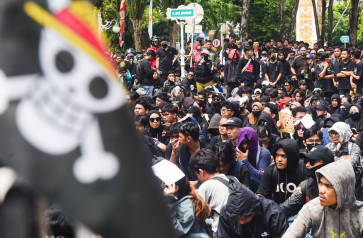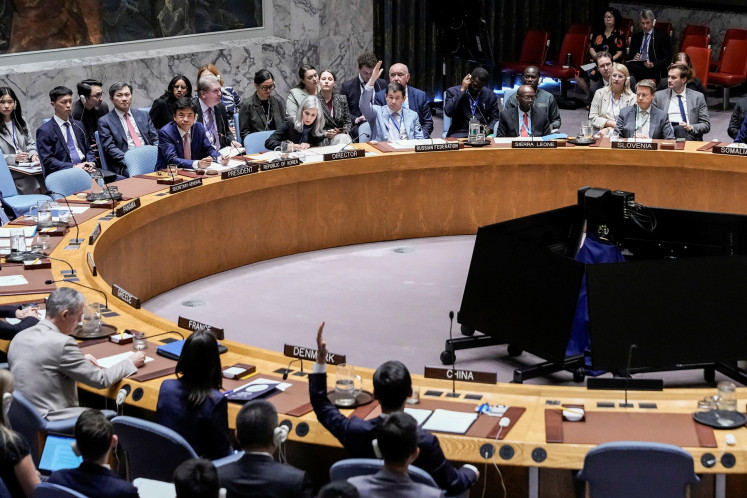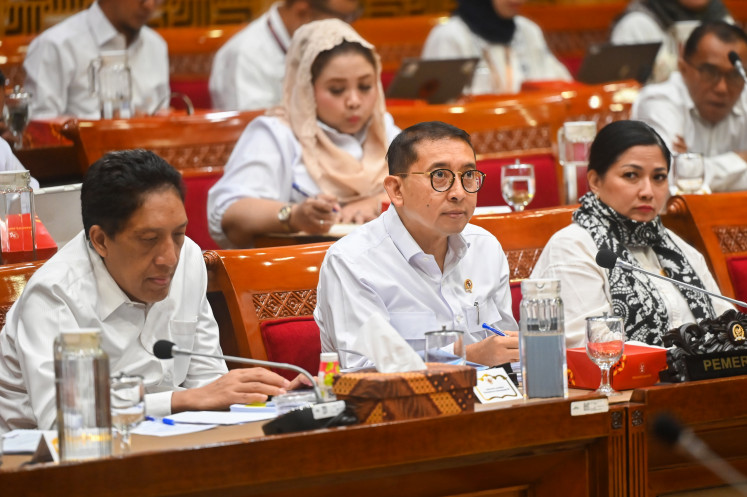Popular Reads
Top Results
Can't find what you're looking for?
View all search resultsPopular Reads
Top Results
Can't find what you're looking for?
View all search results‘Trajectory’ A decade of Lawangwangi creative space
Delicate: In his paper handcut work, titled Invisible Monster, artist Mujahidin Nurrahman points to the chaotic mess of current situations
Change text size
Gift Premium Articles
to Anyone
D
elicate: In his paper handcut work, titled Invisible Monster, artist Mujahidin Nurrahman points to the chaotic mess of current situations.
The exhibition “Trajectory” at Lawangwangi Creative Space in Bandung, West Java, showcases works – both virtually or by appointment – by 10 artists who have made make their mark in the past decade with innovations in concepts and materials.
Lawangwangi, which literally means “alluring gate”, had its 10th anniversary in late March.
The creative space, set up by mathematician Andonowati, rose from the initial “Art and Science Estate”, combining a gallery and a science lab, to a splendid entity called “Lawangwangi” which supports and promotes Indonesian artists to an elevated level.
Standing out in its endeavor in the past decade is, among others, the Bandung Contemporary Art Awards (BaCAA), which has gained a reputation of being unique and inspiring with its bold and daring initiatives and decisions.
Andonowati, the driving force behind Lawangwangi, has also been hailed as knowing the balance between ideological and commodification of art.
The latest exhibition of the works by 10 selected artists was to be held at the gallery to mark Lawangwangi’s 10th anniversary, but due to the COVID-19 outbreak, the works are being shown online or by appointment only.
The 10 artists – veteran and new generation artists – show how conceptual thought by veteran artists like Tisna Sanjaja, Heri Dono and Mella Jaarsma are being drawn to social situations of the present; while the younger generation excels in experimental innovations combined with scientific and technological execution.
Tisna and Mella, for instance, tackle sociocultural issues.
At the exhibition, Tisna showcases videos that represent his social and environmental projects in Cigondewa, where he believes art can be an agent of change in sociopolitical and environmental stalemates.
Mella, with her installations of Blinkers, points at an opposite one-sidedness in the cultural tradition of clothing, such as in Indonesia’s westernmost province, Banda Aceh, where bodies must be almost totally covered according to sharia; and people in the country’s easternmost province, Papua, who are still using little coverings as many tribal people are wearing penis sheaths or grass skirts.
Both Tisna and Mella are interested in the politics of culture.
Meanwhile, Heri Dono – known for his fondness of simple technology – presents work from 2018 using genetic manipulation with mechanical devices. He is concerned about the impact of advanced science and technology on the human body that together with other elements of the universe, may one day be hybridized into new creatures as living Avatars.
In the meantime, the younger generation has immersed themselves in exploring the workings of scientific and new technological advancements to discover other ways of doing in contemporary art.
Arin Dwihartanto, for instance, widely explored pigments, ultimately creating his own powder pigments through alternative methodologies, utilizing, among others, volcanic ash derived from volcanic eruptions, various metals and minerals from the earth, as well as, most recently, perishable food ingredients and spices and treated these materials as a deep source of pigment exploration. The title of his work Phreatic refers to his process with volcanic ash.
Bandu Darmawan in Gelombang Terakhir (Last Wave) simulates, manipulating phenomenon and recording culture-also pictorial one into a compact AR installation formed in analog Hi8 video camera (as a representation to the last analog video which mass-produced) into an artwork.
Eddy Susanto’s innovation using Javanese script in relation to Renaissance works, has been an important phenomenon in the past decade.
In his current work The Decalogue, the artist honors Lawangwangi’s anniversary by appropriating the works respectively Moses and the Copper Snake by Renaissance painters Egbert van Panderen after Pieter de Jode, and Mozes by Cornelis Galle after Jan van der Staet, to emulate The Ten Commandments written in Javanese script shaping the images in these works.
Etza Meisyara has emerged as an innovative multimedia artist whose works have included sound, etching and other media. With Garam di Laut, Asam di Gunung, Bertemu dalam Belanga (Salt in the Sea, Acid on the Mountain Meets in One Cauldron), a photo etching, she uses brass and sulfur from the mountain as her main material, letting the color emerge as a result of the burning process.Cultural issue: Through her installation, Blinkers, artist Mella Jaarsma points at an opposite one-sidedness in the cultural tradition.
Jim Allen Abel – an artist known for his photography and installation works – in Speculative Realism also comments on the changes over time.
“I noticed how human gestures evolved along with history, and how some of these dominant gestures nowadays did not even exist in the previous eras. And effects of the internet on human lives and their way of life,” he says.
Mujahidin Nurrahman’s paper cuts are at once beautiful, delicate, revealing and foreboding.
In a continuation of his paper cuts in the arabesque style layering of AK47 weaponry, that deceivingly appear as ornamental decorations, the artist with his work Invisible Monster in fact wants to point to the chaotic mess of current situations where violence results from the power clash and religious motivations.
However, the symbolism of the symmetrical form likened to Arabesque (geometrical) design that create visual balance presents a platform or means toward an “ideal” greater picture.
Tromarama, the Indonesian first video group to enter the contemporary scene, in their work Marvin, reconsider the relation between species and nature as the habitat of all things living. They also consider how nowadays simulation of the various space for humans and other living things are catered through technological devices.
Attempting to break down the role of contemporary technology in creating new associations between man, animal and nature, they have used computer engineering to have a penguin as the narrator in Marvin’s work, highlighting an animal’s perspective instead of personal narratives by zoo veterinarians and academics of animal behavior and communication mediators between species.
Perhaps the works of these artists – selected and curated by Asmudjo J. Irianto and Gumilar Ganjar as representing the development of Indonesian art in the past decade – may inspire to imagine the next decade after the COVID-19 rage is over. (ste)
— Photos courtesy of ArtSociates Indonesia
______
Trajectory: A decade of Lawangwangi exhibition
Online viewing April 24 to May 24 at artsociates.com; by appointment to Yori +62 87823416728; or email for further details to info@artsociates.com












